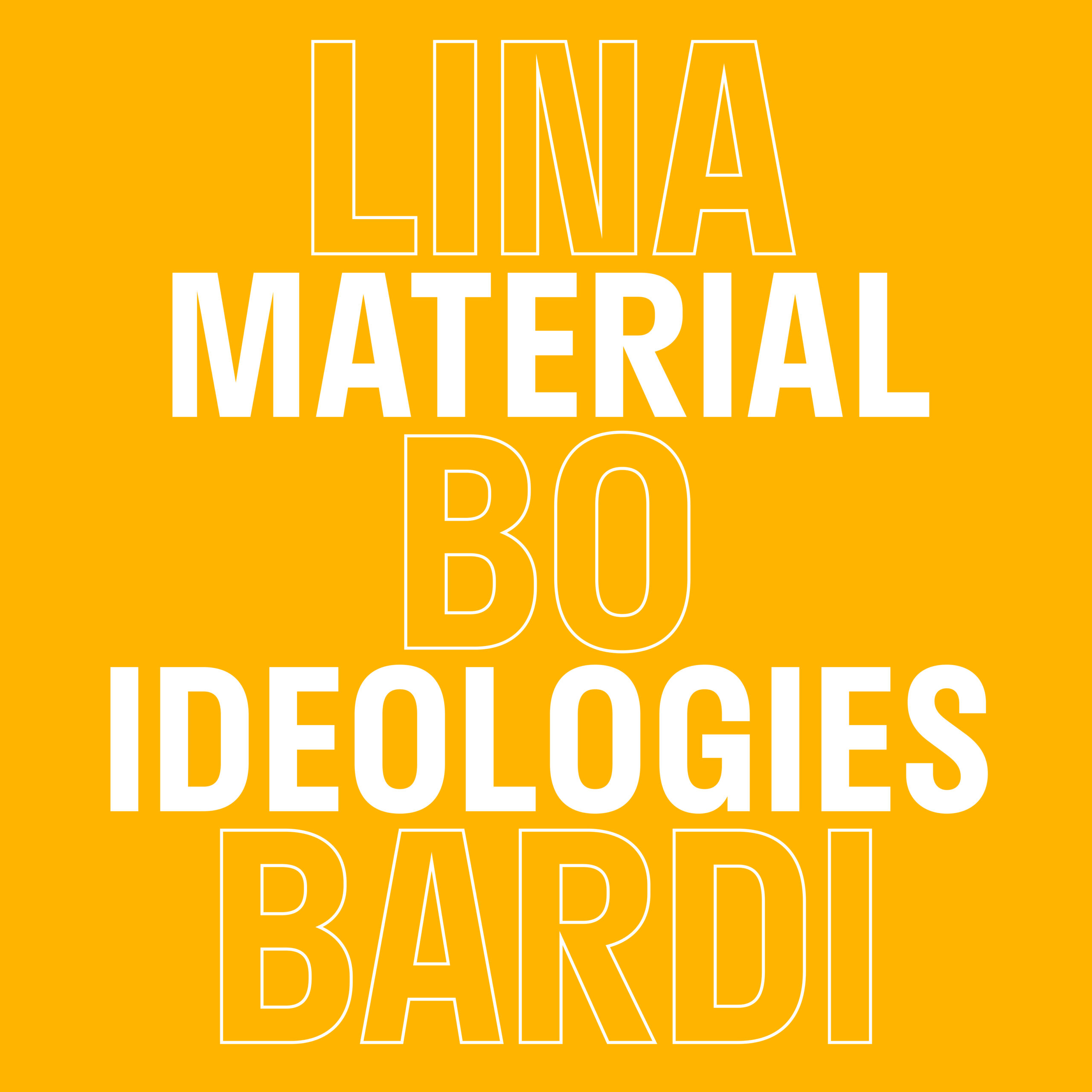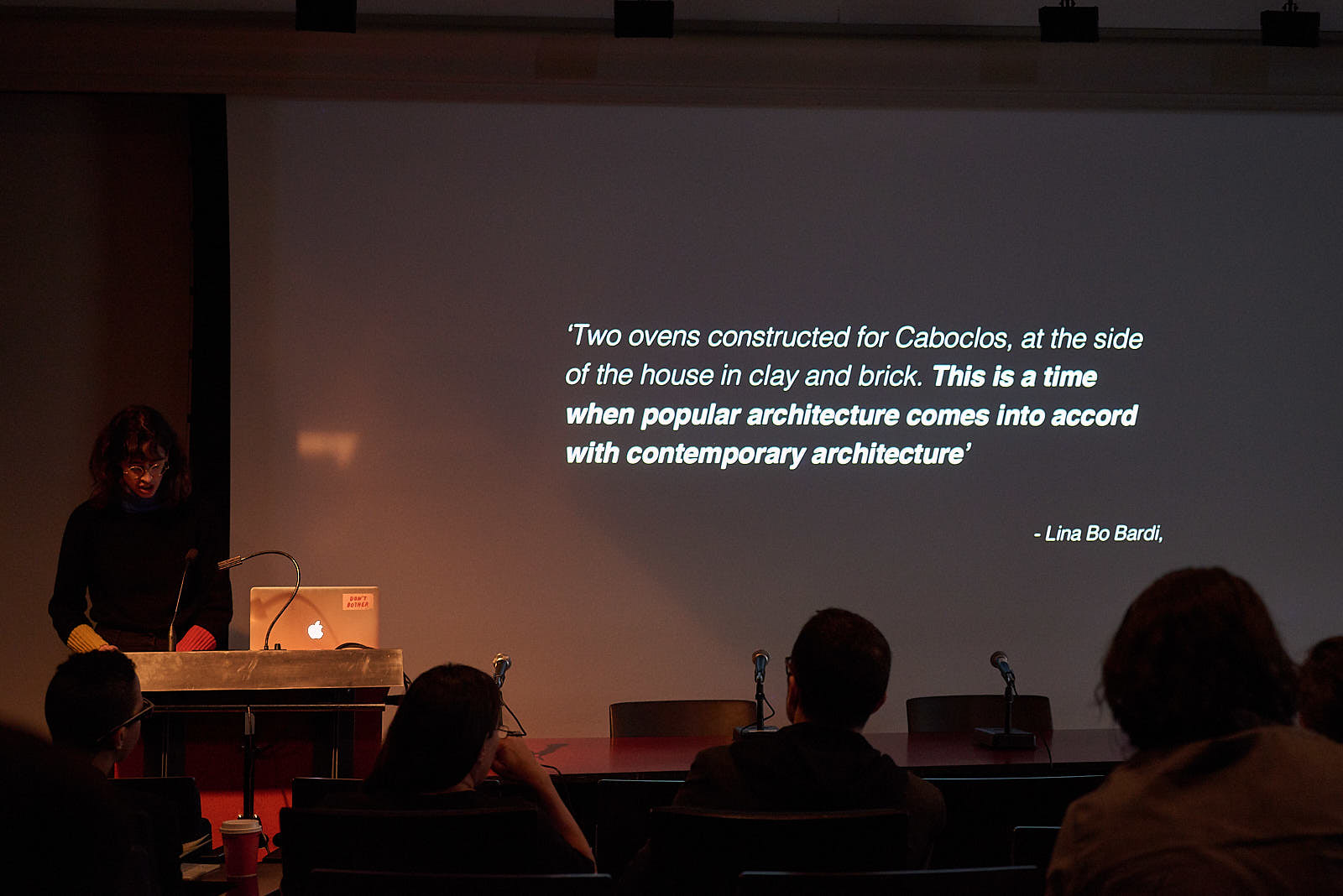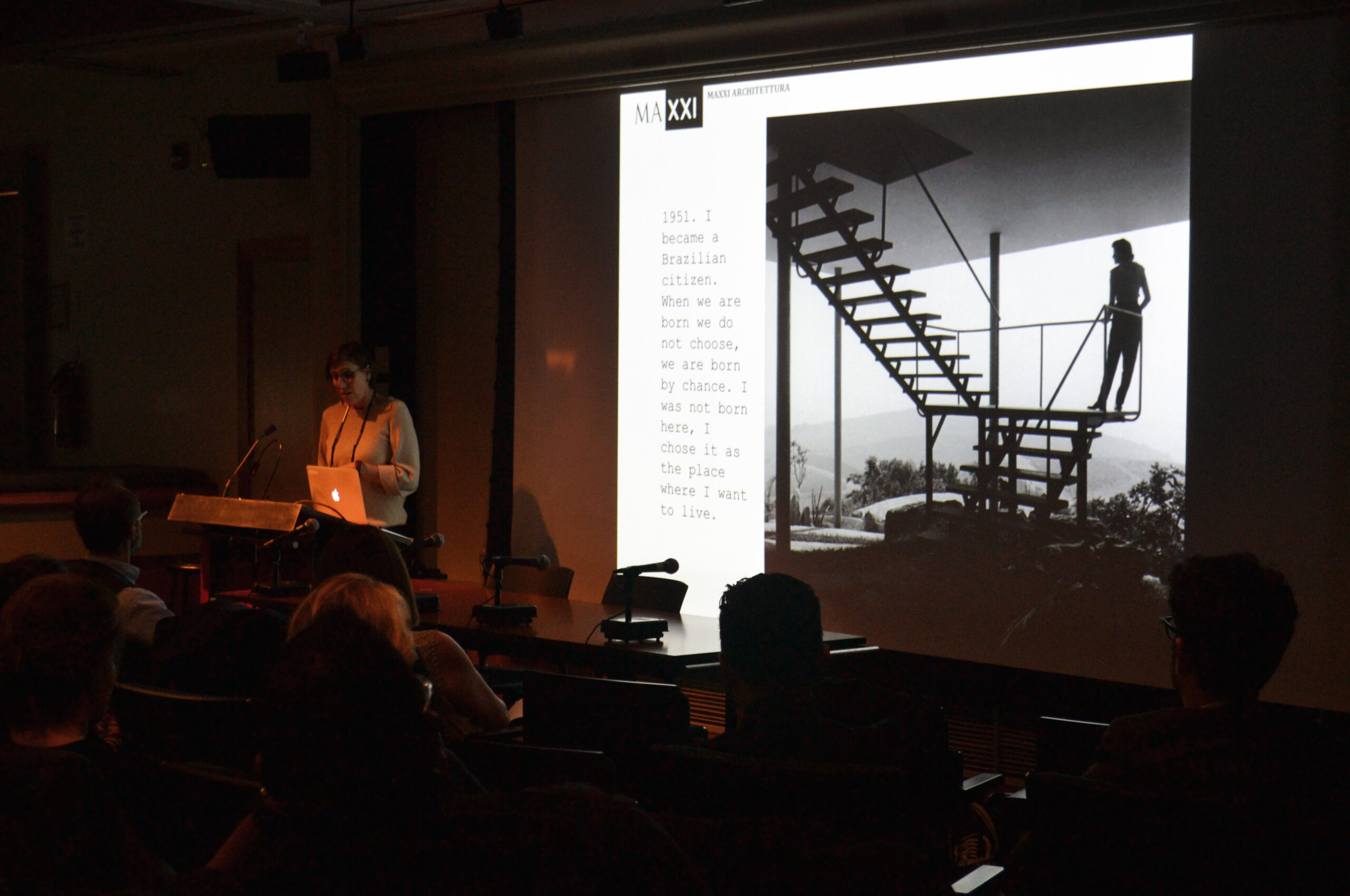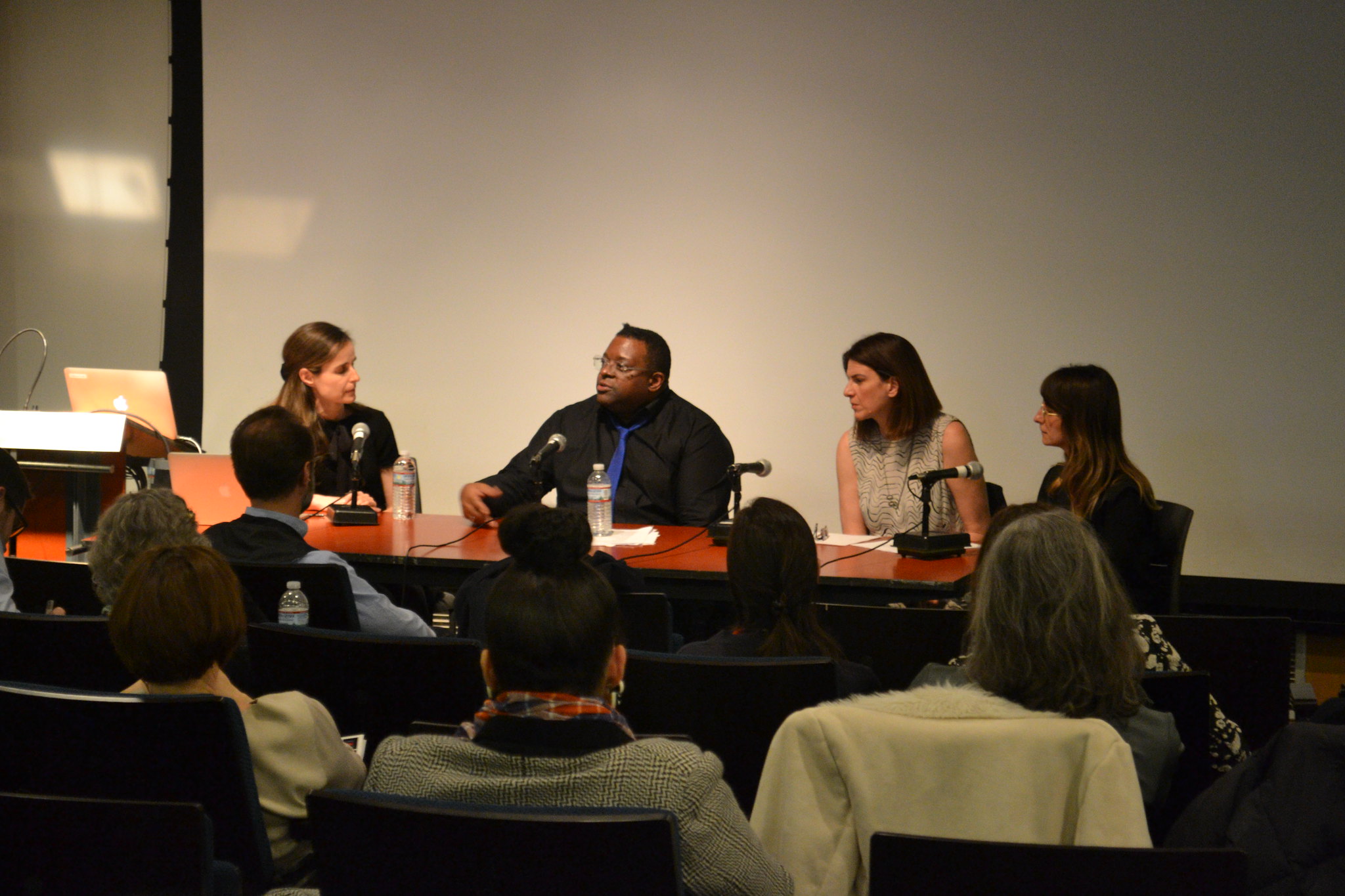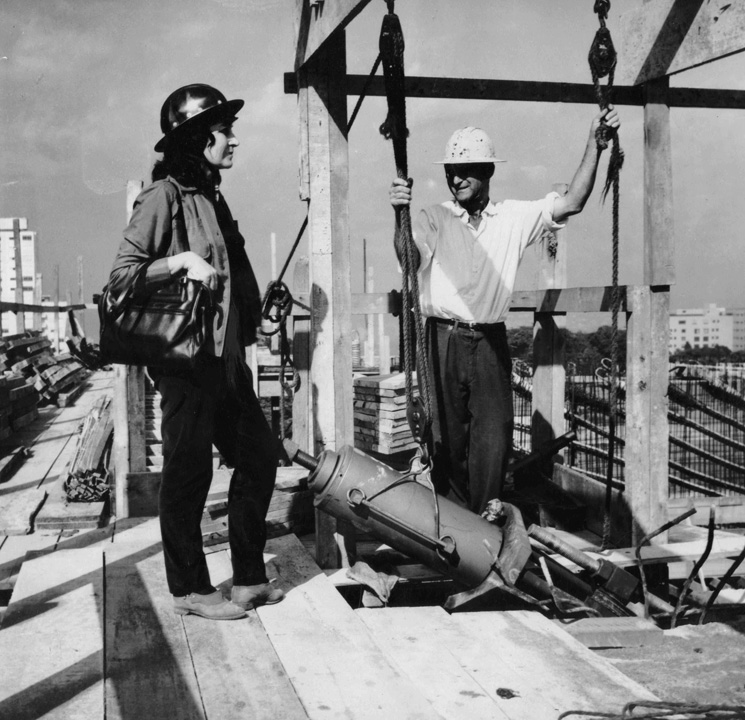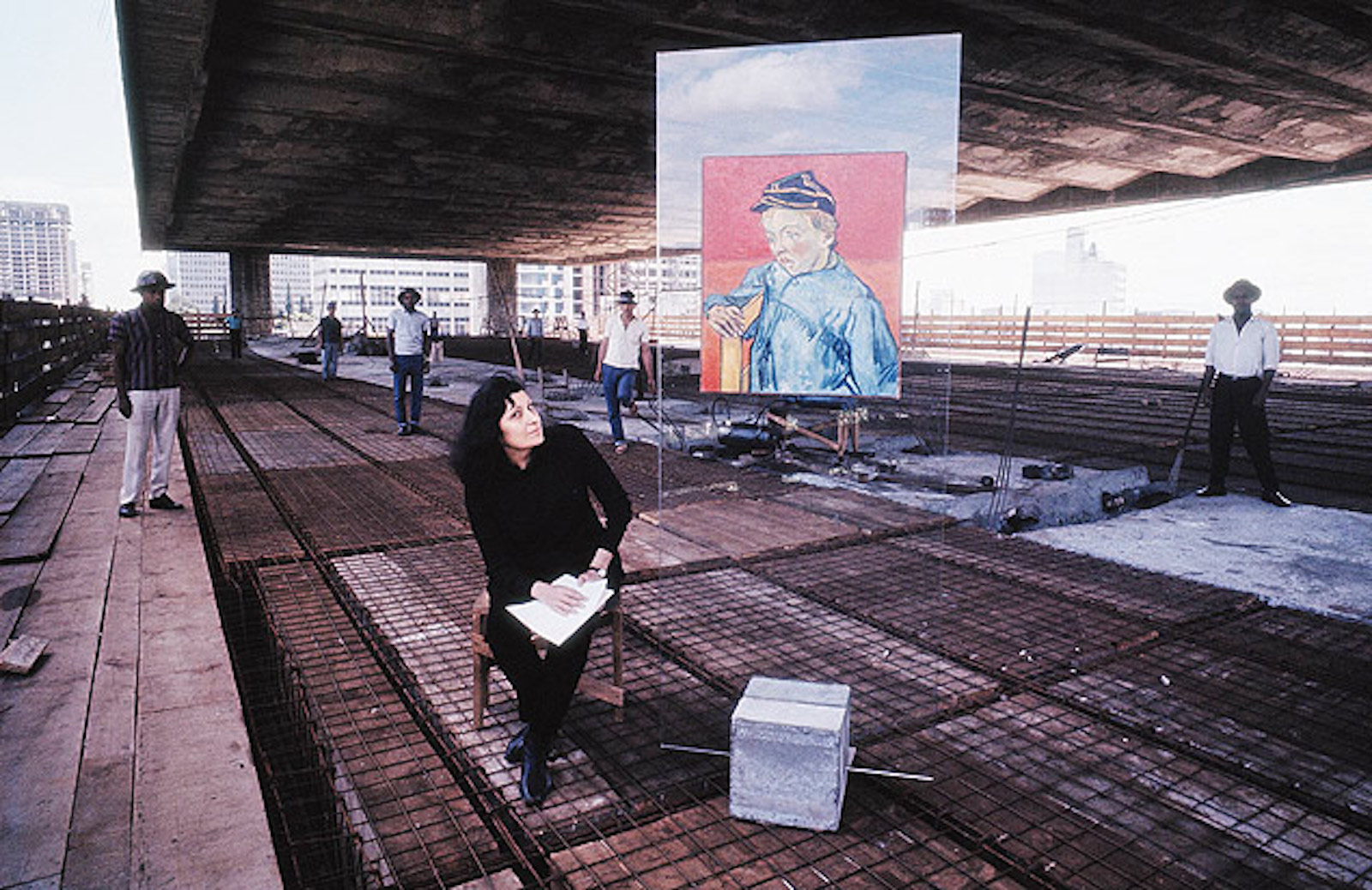March 30, 2018-March 30, 2018
Lina Bo Bardi: Material Ideologies
Lina Bo Bardi: Material Ideologies presents new perspectives on Bardi as an architect, designer, writer, and activist, among many other things, to engage recent interest and discourse surrounding her work. Whether tectonic or conceptual, social and political agendas are latent in Bardi’s architectural materials, a theme that informs each conference panel: from her application of concrete, to the implementation of nature in schemes, and her reuse of vernacular materials.
Organized by Women in Design and Architecture (WDA) at Princeton University School of Architecture, this annual conference celebrates the work and legacy of a pivotal female architect or designer with contributions from international historians and scholars, in addition to artists and curators.
This conference is made possible by the Jean Labatut Memorial Lectures in Architecture and Urban Planning Fund and the Program in Latin American Studies at Princeton University.
WDA Student Group
Kate Bilyk, Kate Chiu, John Cooper, Ece Emanetoglu, Jiawei Jerry He, Jose Ibarra, Sheila Lin, Andrea Ng, Anna Renken, Gillian Shaffer, Eda Yetim
Concrete Brut
The use of concrete in Lina Bo Bardi’s architecture supersedes conventional understandings of the brutalist building material as a tectonic aggregate rooted in European Modernism. Bardi’s concrete brut offers an alternative knowledge of a material technique and application often personified as masculine. Instead, her concrete exerts the cultural weight of a radical practitioner, her cultural interests in Brazilian vernacular and the social implications of modernist architecture.
Natura
While Lina Bo Bardi’s architecture is inherent with materiality, its relationship to unconventional notions of material—such as nature—propose an alternative reading of her work. Instead, an architecture bound to nature’s extents of place and time is constructed with foliage, earth, light, color, sound, smell, and texture. Bardi’s temporal materiality is not an entropic architecture, but rather a subtle harmony between architecture and nature.
Material Re-Use
History and socio-cultural material is the existing strata of any re-use project. Lina Bo Bardi’s investment in such materials are evident through her involvement in exhibitions, performances, publications and ultimately, architectural production. Bardi’s seminal projects address the adaptive reuse of existing architectural sites, yet the specific reuse of materials—whether tectonic or “paper”—equally demands inquiry.
Sol Camacho
Sol Camacho
Cultural Director, Instituto Bardi / Casa de Vidro
Sol Camacho, born in Mexico City in 1981, is an architect and urban designer who graduated from Harvard GSD (2008). She is the Cultural Director of the Instituto Bardi/Casa de Vidro Institution founded by Lina Bo and Pietro Bardi. In this role Sol manages the Bardi’s archive and the cultural program of Casa de Vidro. She curated the international exhibition “Glass Houses”’ and “Lina’s Garden: An ongoing Landscape Construction’”(2017).
Sol is the founding partner of the architecture office RADDAR in São Paulo (2011) which was recently awarded the Silver Lafarge Holcim Award in Latin America (2017). Among her professional recognitions, Camacho was selected as a candidate for the Rolex Mentor and Protégé Arts Initiative (2016) and twice earned the FONCA research scholarship (2012, 2014).
She is the curator for the Brazilian Pavilion at the 16th International Architecture Exhibition of the Venice Biennale.
Bruno Carvalho
Bruno Carvalho
Associate Professor of Spanish and Portuguese, Princeton University
Bruno Carvalho’s research and teaching interests range from the early modern period to the present, and include literature, culture, and the built environment in Latin American and Iberian contexts, with a focus on Brazil. He has published widely on topics related to poetry, film, architecture, cartography, city planning, environmental justice, race and racism. Carvalho is the author of the award-winning Porous City: A Cultural History of Rio de Janeiro (2013) and co-editor of several books, including Occupy All Streets: Olympic Urbanism and Contested Futures in Rio de Janeiro (2016). He is co-editor with Felipe Correa of the new book series Lateral Exchanges (U of Texas Press), devoted to architecture and urbanism. Carvalho is working on a book on how various designers, writers and artists imagined urban futures in the past. At Princeton, he co-directed the Princeton-Mellon Initiative in Architecture, Urbanism & the Humanities until 2017, and is Associate Professor in Spanish and Portuguese, as well as Associated Faculty in the Departments of African American Studies, Comparative Literature, the Princeton Environmental Institute, the Program in Latin American Studies, the Program in Urban Studies, and the School of Architecture.
Martín Cobas
Martín Cobas
Professor of Architectural History and Design, School of Architecture, Design and Urbanism of the Universidad de la República; Ph.D. Candidate, Princeton University School of Architecture
Martín Cobas is a Ph.D. Candidate at Princeton University School of Architecture. His research examines the historical intersections of anthropophagic, baroque and magical discourses in the “creaturely” origins of Brazilian modernity and the construction of a critical visual and spatial ontology. He is co-editor of Vitruvia and his writing has appeared in specialized journals (Architecture & Culture and PLOT, among others), and is currently completing a book on the work of Uruguayan engineer Eladio Dieste. Honors include the Archiprix International Graduation Project Award, Glasgow, 2005, and the Julio Vilamajó Prize, 2012. Cobas is a founding partner of Fábrica de Paisaje, whose work has received several international awards and has been exhibited in Buenos Aires, Medellín, Mexico City, Barcelona, New York, Montreal, Reggio, and the Venice Architecture Biennale. He graduated in architecture from the School of Architecture, Design and Urbanism of the Universidad de la República (FADU- UdelaR) in Montevideo, and holds a Master’s degree in Design Studies in History and Theory (with Distinction) from the Harvard Graduate School of Design. Cobas is Professor of Architectural History and Design at FADU- UdelaR (where he served as Associate Dean) and a researcher at the Institute of the History of Architecture. He has taught in Brazil, Ecuador and the US, and is a member of the South America Project (Harvard/DRCLAS).
Mike Cooter
Mike Cooter
Artist
Mike Cooter’s work investigates the structural agency of objects, be they sculpture, cinematic props or other anthropological artefacts – objects co-opted or created to drive narratives, fictional or otherwise. Working primarily with installation, Cooter’s interdisciplinary practice also resolves into text, radio production and curatorial projects. He has lectured widely, written on the history of exhibitions and recently completed a PhD at Goldsmiths, London on MacGuffins – mysterious narrative drivers emerging from film and literary history. His work has been included in recent exhibitions at the Swiss Institute (New York), Stroom Den Haag (The Hague), the 31st Biennial of Graphic Arts (Ljubljana), Boghossian Foundation / Villa Empain (Brussels), Tenderpixel (London) and Witte de With (Rotterdam). His solo project The Mimic, the Model and the Dupe is currently at the New Walk Museum (Leicester) until May. Documentation of these and other projects can be found at www.mikecooter.org.
Rafaela Mendes Ferreira
Rafaela Mendes Ferreira
Art Historian & Researcher, Isaac Julien Studio
Rafaela Mendes Ferreira is an art historian, independent researcher and curator based in London, UK. She holds an MA in Art History from the University of Warwick, UK, and a BA in Fine Arts from Fundação Armando Álvares Penteado (FAAP), Brazil. Her research has been published in The Art Market Dictionary and she has collaborated with Brazilian art galleries and institutions such as Associação Cultural Videobrasil and Galeria Nara Roesler. She has co-curated the exhibition “Isaac Julien: Ten Thousand Waves” at MAC Niterói, Rio de Janeiro. Currently working as Head of Research at Isaac Julien Studio, she has been undertaking research on Lina Bo Bardi, Frederick Douglass, and the narratives involved in multiple screen film installations.
Jane Hall
Jane Hall
Member of Assemble; PhD Candidate, Royal College of Art
Jane studied architecture at King’s College Cambridge and the Royal College of Art in London. She is a founding member of the architecture collective Assemble who won the Turner Prize in 2015. Jane is currently a PhD candidate where her thesis builds on the research she conducted as the inaugural recipient of the British Council’s Lina Bo Bardi Fellowship in 2013. Her study concerns the alternative practices of Bo Bardi in Brazil in comparison with the architects Alison and Peter Smithson in the UK, focusing on how postwar architecture was shaped by the Modern Art Movement on both sides of the Atlantic. Jane’s work on public space, occupation and collective action in Brazil has been published in Blueprint Magazine, The Architectural Review and most recently, Matzine.
Isaac Julien
Isaac Julien
CBE RA, Artist & Filmmaker, Isaac Julien Studio
Isaac Julien CBE RA is a Turner prize nominated artist and filmmaker. Julien creates multi-screen film installations and photographs that incorporate different artistic disciplines to create a poetic and unique visual language. Born in 1960 in London, he is one of the most prominent figures at the intersection of media art and cinema today. While studying painting and fine art film at St Martin’s School of Art from which he graduated in 1984, Isaac Julien cofounded ‘Sankofa Film and Video Collective’ in which he was active from 1983-1992.
Julien’s debut film Looking for Langston garnered the artist a cult following. The acclaimed 1989 documentary-drama, explores author Langston Hughes and the Harlem Renaissance. Earlier works include Young Soul Rebels (1991), which was awarded the Semaine de la Critique Prize at the Cannes Film Festival. His 1996 film Frantz Fanon: Black Skin, White Mask has been newly conserved and restored by the British Film Institute and was re-launched in a Blu-ray version in 2017.
Julien has pioneered a form of multi-screen installations with works such as Western Union: Small Boats (2007), which won the Charles Wollatson Award in 2017, Ten Thousand Waves (2010) and Playtime (2014).
Julien’s work is included in the collections of institutions around the globe, such as Tate, London; the Museum of Modern Art, New York; Centre Pompidou, Paris; the Solomon R. Guggenheim Museum, New York; the Zeitz Museum of Contemporary Art (Zeitz MOCAA), Cape Town and Towner Art Gallery Collection, Eastbourne, UK. In 2013, a monographic survey of his career to date, Riot, was published by MoMA, NY.
Veronika Kellndorfer
Veronika Kellndorfer
Artist
Veronika Kellndorfer lives and works in Berlin, Germany. She has developed international solo exhibitions in outstanding institutions, including the National Museum in Oslo, Norway (2017); Casa de Vidro, Instituto Lina Bo Bardi in São Paulo, Brazil (2015); Pinakothek der Moderne in Munich, Germany (2012 and 2014); Berlinische Galerie in Berlin, Germany (2005); and Villa Massimo in Rome, Italy (2005). Her work is part of the permanent collections of the Hammer Museum in Los Angeles, CA; San Francisco Museum of Modern Art, San Francisco, CA; Pilara Foundation, Pier 24 Photography, San Francisco, CA; National Gallery, Hamburger Bahnhof, Berlin; and Museum of Contemporary Art San Diego, San Diego, CA, among others.
In her series Tropical Modernism, Kellndorfer examines modernist structures unfolded by Lina Bo Bardi, Artigas, Burle Marx and Niemeyer, from which she enlarges printed photography on highly reflective glass panels. She primarily focuses her lens on the transparent structures of the facades, allowing the inside and outside to play on the glass’ surface. As result of this process, the viewer and their surroundings are conflated on the works’ different layers, merging the image space and real space, the hand-made and the natural.
Zeuler R. Lima, Ph.D.
Zeuler R. Lima, Ph.D.
Associate Professor in the School of Design and Visual Arts, Washington University in St. Louis
Zeuler R. Lima, Ph.D. is an educator, scholar, architect, artist, curator, writer, and above all a humanist. He received his professional and doctoral education at the University of São Paulo School of Architecture and Urbanism and post-doctoral education in Comparative Literature at Columbia University. Lima is author of the acclaimed biography Lina Bo Bardi (Yale University Press, 2013) and publications in international books, exhibition catalogues, and journals. He has held teaching and research appointments at the University of São Paulo, Ecole d’Architecture de Grenoble, Columbia University, University of Michigan, Tokyo Hosei Daigaku, and Washington University (St. Louis and Florence). He is a curator of architecture exhibitions, including the upcoming show, “Drawn by Hand: Architecture according to Lina Bo Bardi” at the Fondació Joan Miró Barcelona (Spring 2019). Lima develops work in drawing and conceptual art, including the current exhibition “Found in Translation” (Tokyo, March 2018). More information on his work can be found at https://zeulerlima.com/.
Silvia Perea
Silvia Perea
Art and Architecture Curator
Silvia Perea is an architect, Ph.D., and art and architecture curator. Spanning over 15 years, her career combines researching, teaching, publishing and curating exhibitions. Dr. Perea holds a Master’s Degree in Architecture, and a Ph.D., Summa Cum Laude, from the Polytechnic University of Madrid. Currently, Dr. Perea is pursuing a Master’s Degree in Museum Studies through the Extension School of Harvard University. Between 2008 and 2014, Dr. Perea was affiliated to the Graduate School of Architecture, Planning, and Preservation of Columbia University, where she was Adjunct Professor. Previously, she had taught studio at universities in Spain, Portugal, Brazil, and India. Adding to her academic experience is a solid record of lectures in European, Asian and American countries, as well as the publication of articles in specialized magazines. Dr. Perea has been editor of art and architecture for the Spanish magazine Arquitectura Viva and she is currently external collaborator of Domus Mexico, Center America, and the Caribbean. For the past four years, she has served as curator at The Baker Museum, in Naples, Florida, where she has developed over half a dozen exhibitions and contributed to the development of over 15 more. Through her multifaceted background and practice, Dr. Perea strives to reveal fruitful correspondences between art and architecture aiming at inspiring new and urgent considerations upon both.
Silvana Rubino
Silvana Rubino
Associate Professor, Department of History, State University of Campinas
Silvana Rubino has a PhD in Social Sciences (Unicamp) and postdoctoral studies at EHESS, Paris. She organized Lina por escrito (2009) and co-organized Domesticidade, gênero e cultura material (2017). She also was a curator for the exhibition “Ocupação Mario de Andrade” (São Paulo, 2013) and was curator-assistant for the exhibition “Lina Bo Bardi 1914 in Rom geboren” (“Lina Bo Bardi born in Rome in 1914”) (Johann Jacobs Museum, Zurich, 2014). She has published many articles and book chapters on modern architecture, cultural heritage and intellectual history.
Elena Tinacci
Elena Tinacci
Architecture Historian, MAXXI National Museum of 21st Century Art
Elena Tinacci, architect and architectural historian, Ph. D., carries out research within the Architecture Department of the MAXXI Museum of Rome, where she curates and coordinates projects on the museum’s collections. She has collaborated with important cultural institutions such as the Fondation Le Corbusier and Docomomo International in Paris, and with public institutions such as the University of Roma Tre and the Ministry for Cultural Heritage and Activities. Among the projects developed for the MAXXI, she coordinated the research for the exhibition Lina Bo Bardi. Quello che volevo era avere Storia (2014) and she curated the exhibitions Carlo Scarpa e il Giappone (2016) and Interiors. Le stanze del quotidiano (2017). Author of a number of papers and publications mostly connected to her studies on Le Corbusier and Carlo Scarpa, she has recently published with Edizioni di Comunità Mia memore et devota gratitudine. Carlo Scarpa e Olivetti 1955-1978.
Cathrine Veikos
Cathrine Veikos
Associate Professor of Architecture, Chair of Interior Design, California College of the Arts
Cathrine Veikos is an architect and author of the book, Lina Bo Bardi: The Theory of Architectural Practice (2014) and essays for the museum catalogues, Lina Bo Bardi and Albert Frey: Search for a Living Architecture (Palm Springs Museum, 2017), and Lina Bo Bardi 100 (Architekturmuseum, Munich, 2015). Veikos has also published widely on Bo Bardi including in the Journal of the Society of Architectural Historians (JSAH), the Journal of Architectural Education (JAE) and in the Brazilian publication, ArqTEXTO. She is a Professor and Chair at the California College of the Arts in San Francisco.
Friday
March 30th
Introduction to Lina Bo Bardi: Material Ideologies
Jane Hall, Member of Assemble; PhD Candidate, Royal College of Art
Mike Cooter, Artist
Discussion moderated by Martin Cobas Professor of Architectural History and Design, School of Architecture, Design and Urbanism of the Universidad de la República; Ph.D. Candidate, Princeton University School of Architecture. Introduction by Kate Chiu, WDA Student Member.
"The Political Architecture of Lina Bo Bardi"
Selected clips courtesy of Marcelo Ferraz and Instituto Bardi / Casa de Vidro
Zeuler R. Lima, Ph.D. Associate Professor in the School of Design and Visual Arts, Washington University in St. Louis
Introduction by Anna Renken, WDA Student Member
Silvana Rubino, Associate Professor, Department of History, State University of Campinas
Veronika Kellndorfer, Artist
Discussion moderated by Bruno Carvalho, Associate Professor of Spanish and Portuguese, Princeton University. Introduction by John Cooper, WDA Student Member
Cathrine Veikos, Professor of Architecture, Chair of Interior Design, California College of the Arts
Isaac Julien CBE RA, Artist and Filmmaker, Isaac Julien Studio
Rafaela Mendes Ferreira, Art Historian and Researcher, Isaac Julien Studio
Discussion moderated by Silvia Perea, Art and Architecture Curator. Introduction by Sheila Lin, WDA Student Member
Elena Tinacci, Architecture Historian, MAXXI National Museum of 21st Century Art
Interpretation assistance by José Ibarra. Introduction by Jerry He, WDA Student Member
